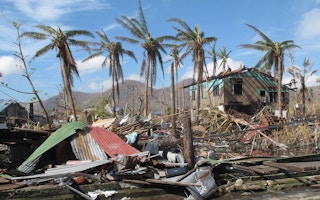During a recent commute to work, as my car inched along in rush-hour traffic, I watched a heron stalk the banks of the Potomac River.
The majestic bird was a timely reminder that nature and beauty can be found in the unlikeliest of circumstances. And yet, even for optimists like me, it is getting harder to be hopeful about the fate of our planet.
Grim environmental news is nothing new, but 2018 brought a deluge of it. One report noted that vertebrate populations have declined by 60 per cent in the last four decades, and less than a quarter of the Earth’s land has escaped the effects of human activity. By 2050, less than 10 per cent of the planet’s land area will be untouched by anthropogenic change.
Perhaps most sobering was a study from the United Nations Intergovernmental Panel on Climate Change (IPCC), which warned that the world is not on track to meet emissions targets needed to keep global warming to 1.5° Celsius above pre-industrial levels, the threshold set by the 2015 Paris climate agreement. The consequences of this failure grow more extreme with every fraction of a degree by which the mark is missed.
Amid these negative trends, some now argue that the world has reached the point of no return for climate change. But, as new findings from The Nature Conservancy indicate, it is not too late to change course.
Last year, we collaborated with the University of Minnesota and 11 other leading academic and research institutions to assess how the world’s future food, water, and energy needs might affect environmental health.
What we discovered is that with smarter strategies, a growing population can be accommodated even as we tackle climate change.
For example, by changing how and where humans grow crops, the world could reduce water stress and dramatically shrink the land footprint of agriculture.
Moreover, our models suggest that by accelerating the transition to cleaner energy, the world could keep the increase in global temperature below 1.6°C – essentially meeting the Paris accord’s target. Best of all, these gains could be achieved while maintaining current trajectories of economic growth.
By implementing a few dramatic but manageable changes over the next few decades, it is possible to realise a sustainable future for both people and nature.
“
We will need new policies that hold polluters accountable, embrace investment in natural infrastructure, establish protected areas, and support smarter planning. But all of this is possible.
Still, despite evidence of what is possible, few countries around the world are acting with any urgency. Climate inaction is often blamed on a “lack of political will.” But it is easy to forget how intentional climate-change passivity is.
For example, policymakers often resist imposing prices on greenhouse-gas emissions, despite the fact that doing so would stimulate the shift toward cleaner energy.
There is also a desire to cater to incumbents in energy and other economic sectors, and an unwillingness to accept the facts of climate change.
We see this repeatedly. In the United States, policymakers and public activists have been discussing climate change for over 30 years but have made only modest gains.
As recently as last November, just weeks after the October release of the alarming IPCC report, a carbon-tax ballot initiative failed in Washington State, one of the most environmentally progressive states in the country.
Similarly, countries around the world have taken only tepid and inconsistent steps to protect biodiversity. In fact, few countries are on track to meet the Aichi Biodiversity Targets, and many governments have actually relaxed protections as they approve development in ecologically sensitive areas.
Moreover, international climate and environmental agreements often lack teeth. While progress has been made to finalise the so-called Paris rulebook – the regulations that will govern implementation of the Paris agreement – most policing mechanisms have encountered resistance from countries that put near-term costs above longer-term benefits.
In fact, a big part of the problem is precisely this either-or framing of the issue. Too often, climate-related strategies are presented as impossible choices between energy security and environmental protection, or between economic growth and reduction of greenhouse-gas emissions.
Our data show that this is a simplistic narrative that won’t serve us well in the long run. The most productive approach is one that accounts for environmental, social, and economic needs.
To be sure, meeting the climate-change challenge will require major adjustments to industrial and agricultural systems.
We will need new policies that hold polluters accountable, embrace investment in natural infrastructure, establish protected areas, and support smarter planning. But all of this is possible.
As with any policy shift, some sectors or individuals will incur new costs; this is especially true for policies addressing pollution, biodiversity loss, and other consequences not accounted for in marketplace transactions.
But polluters should shoulder more of the climate-change burden. For many others – such as farmers, fishermen, and clean-energy producers – upending the status quo would actually bring more economic and environmental benefits, not less.
The stakes are too high for inaction. Around the world, communities are being damaged or destroyed by rising oceans and extreme weather, while safe drinking water is fast becoming a luxury.
I still believe we will navigate the threats we face, but even a climate optimist knows the sentiment may not last forever.
Lynn Scarlett is executive vice president for Policy and Government Affairs at The Nature Conservancy.
Copyright: Project Syndicate, 2019.
www.project-syndicate.org











